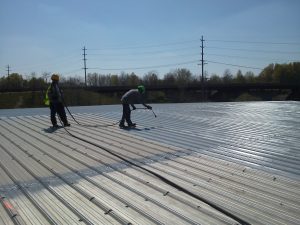Everything You Need To Know About Roof Coatings

Elastomeric Coating System Installation Guidelines
If you think you'll be conserving the roofing system decking plywood (not changing it), then you may save yourself some cleanup trouble by eliminating the fixtures first and after that peeling up the rubber! Detail of water damage on camper roofing system. More water damaged locations on Recreational Vehicle roof decking. There was absolutely nothing actually dreadful that made me feel like I was going to fail, however certainly a great deal of damage and I was getting the feeling I would be changing a great deal of the roofing decking plywood.

Elastomeric Roof Coating & Waterproofing Protection
Check Out This Site: how much does it cost to fix a roof https://pbase.com/topics/ceallava62/whatisar891
I chose the simplest one first, a vent cap from a kitchen sink plumbing vent pipe. Beginning to scrape caulk and sealant. I utilized a stiff scraper with a chisel-like blade and just started prying and breaking and scraping and hacking. There is no other method around this, you simply need to begin digging up until you expose the screw heads.
Unscrewing the screws in vent cap. The screws on this vent cap were hex-head metal screws so I used a small socket driver to remove them. Some came out tidy. Others were rusted and I had to utilize a vice-grip pliers to grab the heads and turn them bit by bit.
I discovered an old wasp nest inside the vent cover. This is a sight I'll most likely need to get utilized to, discovering the remains of animal habitation in every nook and cranny. I spend an awful great deal of my time developing great wildlife environment in my backyard so I do not get angered when an animal picks to set up house in my RV.
How To Apply Roof Coating
Fortunately nobody was home in this old nest so I simply tossed it. Perhaps I'll put a screen over it when changing it. Which brings us to the next point. You must attempt not to harm these pieces (like vent covers and caps) as you're scraping off the old caulk and sealant just in case you require to use them once again.
(Think I'll discover when the roof is done!) Prying up the vent cap and getting rid of the last ring of rubber roofing system below. So I pried up the remainder of the cap and scraped up the staying rubber roofing system and butyl tape and putty and 25 years of other gunk and here's how it looks cleaned up.

White Roof Coating Costs And Benefits
One down, 7 more fixtures to go. Next I chose to tackle the only roofing system ventilation fan that my camper has. My roof vent also had a vent cover over it. So I started scraping the gunk from those screws. Beginning on the roof vent. Hardware exposed on roofing system vent cap, the very first nut came off clean.

Jetcoat Cool King Reflective Acrylic Roof Coating, Waterproof
Bolt is spinning. The fasteners on this Recreational Vehicle roof vent cover were nuts on little bolts. The first one came off great with an extension socket kit. The 2nd one simply began spinning, implying the bolt was not fixed in place but turning in addition to the nut. Bummer. A peek at the hardware holding down the roofing system vent cover.
Elastomeric Roof Coating & Waterproofing Protection
I didn't have any great way to hold the bolt in place so rather I opted to saw through the bolts with a reciprocating saw. Sawing through bolts on roofing vent cover. I utilized a cordless reciprocating saw with a metal-cutting blade however it was difficult to get the blade flat sufficient to reach the bolts so close to the roof deck. Most were so old and rusted that they sheared off when I loosened then with a lot of force. Unscrewing the brackets that held the vent cover in place. Then I scraped more caulk and roof sealant off the flange of the roof vent itself. I soon found there disappeared screws or hardware holding it down so I provided up on the scraping and went inside the Recreational Vehicle After scraping the caulk and sealant from flange of roof vent, say goodbye to screws! Unscrewing the within cover plate of roofing vent fan in RV restroom.
A couple sheared off with a lot of force, but 2 would not budge. So I had to drill out the screw heads. I selected a drill bit near to the size of the shaft of the screws that I had actually currently pulled out and began drilling. Choosing a drill bit for drilling out a screw head.
Security glasses suggested. So I drilled out the heads, one popped off and the other I was getting frustrated with and gave it a yank prior to it was drilled through. Instead of popping off the screw head, the plastic simply dissolved around the hot screw head. Whoops. Hope I don't have to recycle this cover.
If not, I'll need broader screw heads when re-assembling. Cover plate removed from roof vent. Next I discovered little corner brackets with hex-head bolts holding them in. I unscrewed them (all came out great fortunately) and pulled out the brackets and little white plastic spacers. Unscrewing corner brackets in roofing system vent.
Best Practices For Roof Coating Application
https://www.youtube.com/embed/FbHYOfxdj2M
All corner brackets eliminated, prepared to take out. Once the brackets were out I went back up top to pry out the the roofing vent. Then I scraped up all the staying gunk and rubber roofing. Taking off the old roofing vent. There are 2 wires going to the roofing system vent (a black hot wire and a white neutral wire) that you'll need to clip to eliminate the old vent.
